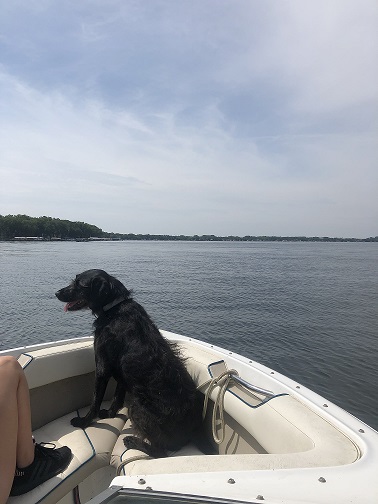Protecting Our Vulnerable Loved Ones from Toxic Algae
posted
by Ingrid Gronstal on Wednesday, August 14, 2019
 I spent the last week with my parents, my niece and nephews, and my dog at Spirit Lake. We swam, boated, floated, and spent the whole week jumping in and out of the water. Luckily, water quality in the Iowa Great Lakes is some of the best in the state, due in no small part to the commitment the community has made to conservation practices and water quality protection in Dickinson County.
I spent the last week with my parents, my niece and nephews, and my dog at Spirit Lake. We swam, boated, floated, and spent the whole week jumping in and out of the water. Luckily, water quality in the Iowa Great Lakes is some of the best in the state, due in no small part to the commitment the community has made to conservation practices and water quality protection in Dickinson County.
I have been an animal nerd my entire life, and my scruffy, doofy rescue mutt may be my favorite creature on this planet (don’t worry, my husband is well aware, and he shares the sentiment). As a water quality professional, I also know all too well the risks that harmful algae blooms carry for those of us just trying to cool off and enjoy ourselves at the lake. For our pets and our children, those risks can be particularly high.
Over the last few days, heartbreaking stories have been circulating on social media and in the news about pet owners and their dogs visiting local lakes for a day of fun, only for their pets to fall ill and pass away within hours of swimming. Imagining this happening to my water-loving lab mix is truly horrifying, as is the idea that children are also especially vulnerable to this toxin.
Recreational lake communities are a vital source of Iowa’s economy, but what happens to these businesses and communities when the water is no longer safe for swimming? What happens to the families that lose a beloved and loyal pet after what should have been a fun family day at the beach? What causes these HABs, and what can be done about them?
First, let's discuss the causes. While algae blooms - even harmful algae blooms - can be naturally occurring, nutrient pollution (excess nitrogen and phosphorus) in our waterways increase HABs.
According to the state’s Nutrient Reduction Strategy (NRS), 92% of the nitrogen in Iowa waters comes from nonpoint sources, the vast majority of which are farm fields. As our recent analysis shows, implementation of conservation practices to reduce nutrient pollution is orders of magnitude slower than necessary to make meaningful progress toward nutrient reduction. That is why IEC is calling for meaningful policy change to increase adoption of conservation practices, including increased incentives and mandatory requirements.
Second, while we work to change policy and increase conservation practices across the state, the Iowa Department of Natural Resources (IDNR) must take its duty to protect human health and the environment seriously where HABs do occur. The Environmental Protection Agency (EPA) recently recommended a microcystin advisory level of 8 micrograms/L for recreational contact.
IDNR has not adopted the EPA’s recommendation, choosing instead to stick with a threshold of 20 micrograms/L. For a beach monitoring program focused almost exclusively on protecting health, what is the downside of choosing the more protective advisory standard? This is not a situation where erring on the side of increased protection will cause economic hardship or regulatory burden – beach advisories simply provide the public with information about the quality of the water in which they plan to swim. If IDNR’s concern is that people will be alarmed by an increased number of swim advisories, perhaps folks should, in fact, be alarmed. Thinking about a dog dying hours after swimming in an Iowa lake or river is alarming.
 It's hard not to get pulled into the details, minutiae, and costs of this work, and sometimes it’s easy to lose sight of the big picture of why we’re fighting so hard for water quality improvements and transparency of information. Public policy can have real, tangible effects on families in our state, both positive and negative. There hasn’t been a heart-wrenching social media post about dogs in Iowa dying from microcystin exposure – yet – and we’re doing our very best to keep it that way.
It's hard not to get pulled into the details, minutiae, and costs of this work, and sometimes it’s easy to lose sight of the big picture of why we’re fighting so hard for water quality improvements and transparency of information. Public policy can have real, tangible effects on families in our state, both positive and negative. There hasn’t been a heart-wrenching social media post about dogs in Iowa dying from microcystin exposure – yet – and we’re doing our very best to keep it that way.
Read more about public beach monitoring, Harmful Algal Blooms, and other water issues in Iowa.
Sign up to receive IEC's Weekly Water Watch, a weekly email providing water news and listing public beach advisories in Iowa.
- beach advisories
- clean water
- dnr
- harmful algal blooms
- microcystin
- nitrate pollution
- nutrient reduction strategy
- phosphorus pollution
- toxic algae
- water quality